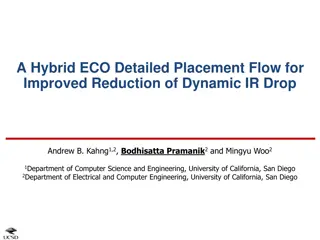
Understanding the Liquid Drop Model in Nuclear Physics
Explore the liquid drop model in nuclear physics, which treats the nucleus as a drop of incompressible fluid. Learn about the five terms of the original formula, the volume term, surface term, Coulomb term, and more that define the nuclear energy. Discover how the model accounts for nucleus stability and the interaction of nucleons, protons, and neutrons within the nucleus.
Download Presentation

Please find below an Image/Link to download the presentation.
The content on the website is provided AS IS for your information and personal use only. It may not be sold, licensed, or shared on other websites without obtaining consent from the author. If you encounter any issues during the download, it is possible that the publisher has removed the file from their server.
You are allowed to download the files provided on this website for personal or commercial use, subject to the condition that they are used lawfully. All files are the property of their respective owners.
The content on the website is provided AS IS for your information and personal use only. It may not be sold, licensed, or shared on other websites without obtaining consent from the author.
E N D
Presentation Transcript
It treats the nucleus as a drop of incompressible fluid and possessing very high density. These are considered to be held together by the nuclear force . there is a similarity to the structure of a spherical liquid.
The original formula defines five terms: Volume energy, nucleons are packed together into the smallest volume, each nucleon has a certain number of other nucleons in contact with it. So, this nuclear energy is proportional to the volume. Surface energy corrects for the previous assumption made that every nucleon interacts with the same number of other nucleons. This term is negative and proportional to the surface area, and is therefore roughly equivalent to liquid surface tension. Coulomb energy, the potential energy from each pair of protons. As this is a repulsive force, the binding energy is reduced. Asymmetry energy It accounts for the Pauli exclusion principle. Unequal numbers of neutrons and protons imply filling higher energy levels for one type of particle, while leaving lower energy levels vacant for the other type. Pairing energy, which accounts for the tendency of proton pairs and neutron pairs to occur. An even number of particles is more stable than an odd number due to spin coupling
The formula EB = avA - aSA2/3 - Z(Z-1)/A1/3- aA(N-Z)2/A +aP A-3/4
Volume term The term avA is known as the volume term. The volume of the nucleus is proportional to A, so this term is proportional to the volume, hence the name. The basis for this term is the strong nuclear force. The strong force affects both protons and neutrons, and as expected, this term is independent of Z. Because the number of pairs that can be taken from A particles is A(A-1)/2, one might expect a term proportional to A2. However, the strong force has a very limited range, and a given nucleon may only interact strongly with its nearest neighbors and next nearest neighbors. Therefore, the number of pairs of particles that actually interact is roughly proportional to A, giving the volume term its form.
Surface term . The term aSA2/3is known as the surface term. This term, also based on the strong force, is a correction to the volume term. The volume term suggests that each nucleon interacts with a constant number of nucleons, independent of A. While this is true for nucleons deep within the nucleus, those nucleons on the surface of the nucleus have fewer nearest neighbors, justifying this correction. This can also be thought of as a surface tension term, and indeed a similar mechanism creates surface tension in liquids. If the volume of the nucleus is proportional to A, then the radius should be proportional to A1/3and the surface area to A2/3
Coulomb term The term Z(Z-1)/A1/3is known as the Coulomb or electrostatic term. The basis for this term is the electrostatic repulsion between protons
Asymmetry term The term aA(N-Z)2/A is known as the asymmetry term (or Pauli term). This is given by Pauli exclusion principle. We consider two different "pools" of states, one for protons and one for neutrons. if there are more neutrons than protons in a nucleus, some of the neutrons will be higher in energy than the available states in the proton pool. If we could move some particles from the neutron pool to the proton pool. The imbalance between the number of protons and neutrons causes the energy to be higher than it needs to be, for a given number of nucleons. This is the basis for the asymmetry term.
Pairing term Magnitude of the pairing term in the total binding energy for even-even and odd-odd nuclei is a function of mass number. The pairing term can be positive for even-even and negative for odd-odd nuclei The term A-3/4is known as the pairing term (possibly also known as the pair wise interaction).






















